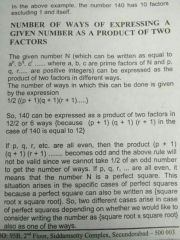![]()
![]()
![]()
Use LEFT and RIGHT arrow keys to navigate between flashcards;
Use UP and DOWN arrow keys to flip the card;
H to show hint;
A reads text to speech;
10 Cards in this Set
- Front
- Back
- 3rd side (hint)
|
Prime number |
Every prime number greater than 3 can be written in the form of (6k+1) or (6k-1) where k is an integer. |
|
|
|
Even prime number |
Only 2 |
|
|
|
Number of prime numbers |
15 between 1& 50, 10 between 50 & 100, 25 between 1& 100 |
|
|
|
Relative prime or co-prime |
Two numbers not having any common factor other than 1. |
Unity is the relative prime to all numbers. |
|
|
Even and odd number |
Sum of odd number of odd numbers is always odd. Sum of even number of odd numbers is always even. Product of any number of odd numbers is always odd. Product of any number of numbers where there is at least one even number is even. |
|
|
|
Perfect number |
A number is said to be perfect number if the sum of all it's factors excluding itself (but including 1) is equal to the number itself. |
|
|
|
BODMAS |
Vinculum bracket - represented by a bar on top. Order of opening brackets : vinculum, simple, curly, square. |
|
|
|
Rules of divisibility |
A number is divisible by 3 if the sum of its digits is a multiple of 3. A number is divisible by 4 if the last two digits is divisible by 4. A number divisible by 6 if it is divisible by both 2 & 3. If the difference between the number of tens in the number and twice the units digit is divisible by 7, then the given number is divisible by 7. A number is divisible by 8 if the last three digits is divisible by 8. A number is divisible by 11if the sum of the alternate digits is the same or they differ by multiples of 11. A number is divisible by 19 if the sum of the tens in the number and twice the units digit is divisible by 19. |
|
|
|
Recurring decimals |
Two types : pure and mixed A recurring decimal is also called a circulator. The digit or the set of digits, which is repeated is called the period.
A pure recurring decimal is equivalent to a vulgar fraction which has the number formed by the recurring digits (called the period of the decimal) for its numerator, and for its denominator the number which has for its digits as many nines as there are digits in the period.
In the numerator write he entire given number formed by the (recurring and non-recurring parts) and subtract from it the part of the decimal that is not recurring. In the denominator, write as many nines as the period and then place next to it as many zeroes as there are digits without recurring in the given decimal. |
|
|
|
Number of ways of expressing a given number as a product of two factors |

Theory |
|

